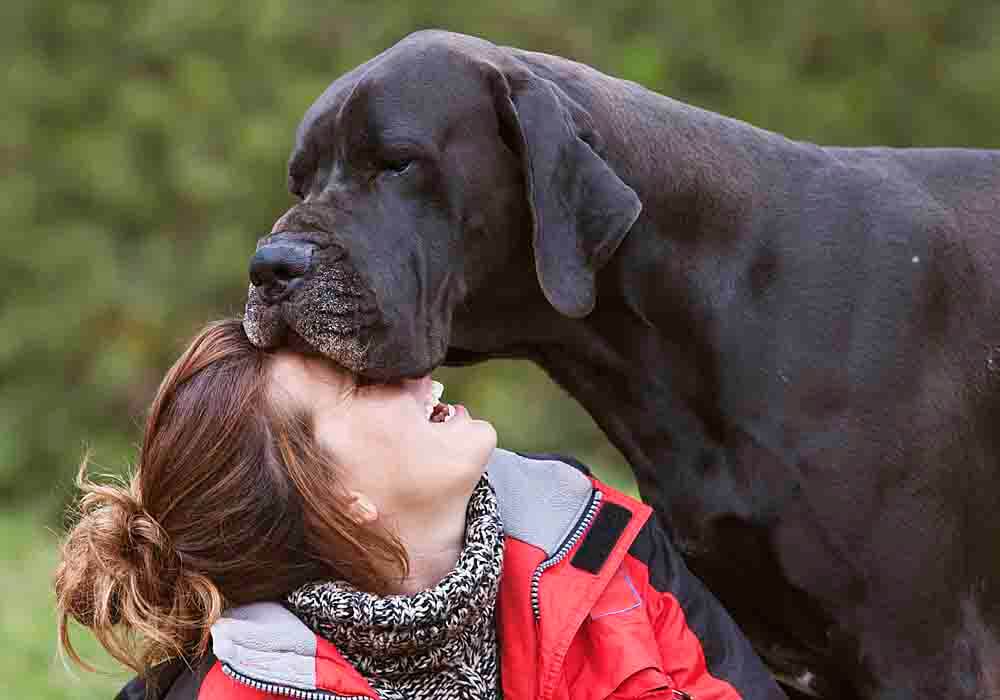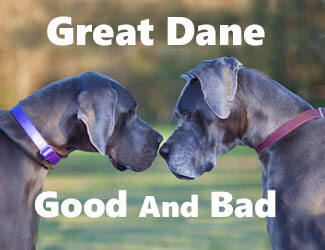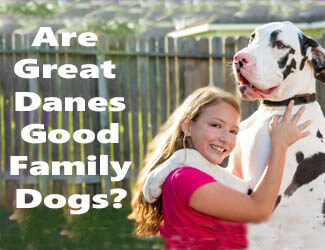How Much Exercise
Does My Great Dane Need?
From Puppy To Adult Their Needs Vary
by Ken Alden
Curious big dog-loving people always find it surprising that Great Danes are such mellow giants. You would expect that dogs bred to hunt wild boar would enjoy tons of high-octane action. But how much exercise does my Great Dane need?
Great Danes need average to low physical activity or exercise. Despite their athletic look, Great Danes, unlike other high-energy dog species, are an average energy breed. That said, to keep them fit and healthy, create a systematic and consistent fitness routine for your dog.
Just like the Bulldog, the Great Dane is an easygoing dog that would love to curl up on your couch all day if you let them. A lack of exercise will, however, make them unhealthy, destructive, and annoying. This article will tackle in detail what sort of exercises are ideal for your huge furry friend. Read More Below...
Pro-tip: Ever try lifting a Great Dane? Their weight can hurt not only your back but their joints when they hop down from cars, sofas or even your bed. To protect your back and theirs check out the best Mastiff ramps on Amazon.com now.
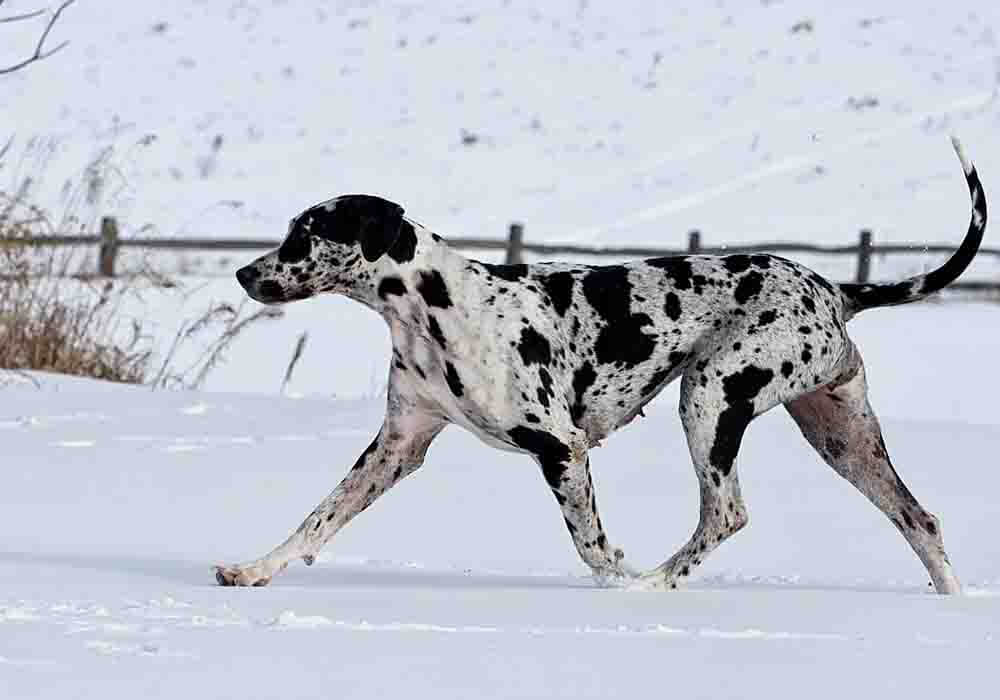
Great Dane Puppies and Exercise
Very few things are as cute as a Great Dane puppy. Two Great Dane puppies though, are cherubic. If you've been lucky enough to watch Dane puppies romp, wrestle, and roll happily, you will see that they get a lot of daily exercises.
They will gently nibble on anything they can find and jump on each other for hours on end. Puppies that have been raised by a good and kind breeder will stay with their mother until they are of age. These Great Dane mothers will also play with their puppies, giving them more exercise. A healthy puppy will, therefore, have plenty of natural exercises and rest in a day.
How Much Exercise Does a Great Dane Puppy Need?
Away from its family, you should give your new puppy sessions of organized playtime and walk. Begin a regular exercise routine for your puppy immediately after you bring them home. Remember that puppies have a natural exercise and rest rhythm and will be active for short spans each day.
Since Great Dane puppies gain rapid height and weight as they grow, their successive swift bodily changes can put a strain on their muscles. You should, therefore, let them have odd leash activities free of high impact strain. Puppies under 18 should have between 15 minutes to 30 minutes of exercise each day.
Great Dane Daily Exercise Requirements for Adults
Great Danes are gentle souls that get along with most humans, animals, and dogs. They are, however, a paradox. Born to hunt and athletic but straight out couch potatoes. As it happens, as part of their breeding process in the 1800s, their German breeders focused on the production of gentle Danes, and they excelled at it.
Today we have a low energy dog with a Mastiff type of ancestry, elegant, sleek, muscular, and athletic. Little to no rambunctiousness in them. There are nevertheless some spirited Danes as well. It is, therefore, difficult to tell when a Dane is under-exercised.
If you are keen on your dog's health and their behavior, you can, over time, learn to tell when they need more physical activity. Some signs that point to a Dane in need of exercise include:
Weight Problems...
As mentioned, these grand dogs are Mastiff in nature and have a lot of definition. They have svelte bodies, massive narrow and long heads, and graceful long necks. An overweight Dane will lose this muscle definition and lose its sleek waist when it begins to bulge.
Too much weight can be catastrophic for this super-sized dog. The extra pounds could adversely affect their big joints. Should your Great Dane show signs of being overweight, formulate a good exercise routine. You can also talk to your vet for diet advice and even further ideas on how much exercise does my Great Dane need?
Destructive Behavior...
Danes are gentle giants whose size can make some folks nervous. Because of their size, these dogs can also make a mess when bored. Not only can their swishing happy tail knock over food and other precious items, but they will also beat against hard items. Furniture, walls, and doors will injure the long thin tail and make it a bloody mess. how much exercise does my great dane need
The massive dog will get into the trash, chew on household items, and make a mess of your carpet. Most destructive behavior in dogs can be exorcised via physical exercise unless it stems from separation anxiety. If the behavior is too extreme, you might need to add a dash of training.
Irritating Barking...
Some pet owners believe that Danes tend to raise their loud barks much more than other large breeds. These immense dogs love to bark. They will go woof over any emotion that they feel. Hungry, bored, or simply want to dash to the yard? Woof! When a Dane wants to go out for a walk, they will not just nudge or eyeball you, but they will bark.
Danes are super communicative, and they will not hesitate to share their thoughts or feelings. Unfortunately, they have a resounding, deep, and intimidating bark. You do not want your gentle communicative giant's overbearing bark ringing in your ears at odd hours because they are bored.
When under-exercised, your dog will bark at anything that creeps outside the door. If your Dane is barking at every minute sound, then they need to get rid of pent up energy. A tired Dane will have less energy to bark at every little thing.
Pro-tip: Great Dane anxiety, aggression, destructive chewing, jumping up, fearfulness, and other behaviors can be controlled with the right training program.
Here’s a great course that
addresses these issues along with many other dog training basics: Check it out now!
Best Exercises for Great Danes
Your Dane needs physical exercise to keep its muscles strong. Healthy, robust muscles will support their length and height better and protect their joints. A fit Great Dane will also have fewer health challenges to deal with. As a breed, these large lovable dogs are prone to a wide range of health issues.
Since they are moderately active dogs, they have an admirable level of endurance. Vets say that a half an hour to an hour of physical exercise should help prevent the weight problems, destructive behavior, and the irritating barking in Danes.
The best forms of exercise for a Dane are daily walks, strengthening
exercises, and free play. Strenuous high impact exercise can do more harm than
good to this breed and cause joint pain plus other health problems. An
intelligent, sensitive dog, your Dane will love mentally stimulating activity
as well. Below are some of the best Great Dane exercises. how much exercise does my great dane need
Walking A Great Dane
Danes mature at two. At this point, a great deal of their puppy playfulness has vanished. Their need to exercise will, nevertheless, exhibit itself if they do not have any physical exercise. It is vital not to put too much of a strain on your dog's body. This is the reason walks are the perfect exercise for this breed.
You can subdivide their hour of exercise into three brisk quarter of an hour walks. Afterward, allow them some freestyle playtime. If you have ample time on weekends, give your dog a longer walk session.
Because they are a large dog prone to lumber when pacing your normal walking speed, walk at a brisk pace or jog to speed them up. Their gait will be more natural, and they will have more aerobic exercise. Some precautions that you should take during walks include:
- Keeping an eye out for excessive panting, fatigue, or soreness. Cut short your walk, should your dog struggle.
- Have a muzzle, harness, and collar when exposing the public to your majestic dog. A quality and secure leash will keep your dog safe from traffic. Off-leash, your dog can stir their stumps to speeds of 48 kph (30 mph)!
Games To Play With A Great Dane
A Great Dane might be one of the largest dog breeds in the world, but it is the gentlest. They seek human attention and company, winning over the hearts of many of their owners. Once known as chamber dogs by the German nobles in the 1600s, these majestic dogs were once a pampered breed, complete with velvet lined gilded collar get-ups. how much exercise does my great dane need
Great Dane treasures human interaction. Free play activities, therefore, are not just a source of exercise for your large dog, but an opportunity to bond with them. You can also use these exercises as an avenue to reinforce your dog's training procedures.
Through these games, you can instill adherence to good behavior. Ensure that a chunk of your dog's off-leash playtime has tons of structured events. Some of the best free play Great Dane activities include:
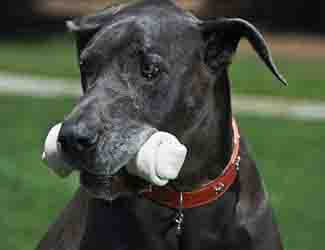
Playing Fetch
Dogs love to play fetch. It is a fantastic pet parent for pet bonding activity as well. The best tennis balls for fetch should have a non-abrasive felt to ensure that they do not chafe under your Dane's powerful jaws.
When playing fetch, keep the activity controlled to ensure that your dog does not over exhaust itself or injure its joints. Use fetch to reinforce the training command, "Come!"
Playing With Other Dogs
Playful activities with its kind will help your dog improve its social skills while burning energy. It will also stimulate their brain.
Hide and Seek
Hide and seek the human is a good way to deepen your dog's adherence to the "Stay!" command. Have your Dane sit and stay and then go hide. Call your dog from your hiding place and watch their face light up after seeking you out. You can make your hide and seek game progressively challenging over time.
Frisbee
Frisbee offers running and tons of jumping, making it a high impact activity for your dog. Playing Frisbee will burn their nervous energy. Ensure that your dog does not overdo it and hurt their joints. Ten minutes of high-energy jumps and runs are enough exercise for your Great Dane.
Garden Hose Play
Hot summers can lead to dehydration and overheating in dogs. Great Danes that cannot regulate their body temperature can suffer from heat exhaustion or heat stroke. Danes love cool water in miserably hot weather.
Use the garden hose to spew water that they can play with. You can also allow them to play with the sprinkler's water. The very first water jet out of the hose on a hot day could be hot enough to scald your dog's hide. Turn it away from them until the water is less hot. how much exercise does my great dane need
Obstacle Course
Some hurdles, a tunnel, and some obstacles in between will make your dog feel like a champ at the end of an obstacle race. You might not even need to order one from Amazon. Simply DIY with materials at home, and your dog will take to it to show you their skills.
Pro-tip: Great Dane's (and their owners) love dog crates…and for good reasons. Crates keep dogs from mischief while you're away, are perfect for house training, for traveling by car, and provide the dog a place to de-stress. Check out the best Mastiff crates on Amazon.com now.
Strengthening Exercises for Great Danes
Great Danes are susceptible to several health conditions. Muscle loss, for instance, can make it difficult for your dog to walk up the stairs or take long walks. Muscle atrophy is common amongst animals, causing weight loss and muscle thinning.
Strength and muscle building exercise can prevent injury in your dog and prevent muscle loss. Powerful muscles will give a boost to the cardiovascular system and prevent weight gain. These exercises also improve gastrointestinal health, eating, and sleeping patterns. Your dog's immune health will also benefit from strength exercises.
Below are some examples of good strength exercises for Great Danes:
- Tug of war. Dogs love tug of war as much as they love to fetch and frisbee. Let your Great Dane crouch and tug a toy. To discourage a dominant attitude in your dog, ensure that your Dane will release the tug toy when you ask them to. This action establishes that you, not the dog, is in control of the activity.
- Stair climbing. Stairs can provide core stability and balance exercises. Let your dog walk up, then down the staircase. They will use their muscles to propel them upward and balance themselves when going downward.
- Doggy squats. Much like human squats, doggy squats are good resistance exercises. You can also use this exercise to reinforce positive behavior in your dog. Use treats if necessary when they respond to "Stand!" Use a backpack to add not over 10% of the dog's body weight after a few weeks of practice.
- Spring pole. Tie or hook up a spring to a beam or branch. Attach to it a toy or lure and let your Great Dane play tug of war whenever they are up to it.
Mental Stimulation for Great Danes
Interactive and puzzle toys will appeal to the large dog's hunter side. Look for toys that stimulate their brains. Mental exercise is an effective nervous energy burner as well.
You are probably wondering what a good toy would be for the "Apollo of Dogs." Danes are so tall that on their hind legs, they can tower over people of average height. They, like any other dog, need play items to keep them busy.
It is either the toys or your new outfit, bags, or expensive leather shoes with our four-legged friends. Toys can cut down this destructive chewing behavior. It is a sight to behold, but Great Danes love their plush toys. Some of these gentle giants will bond with these soft toys, just like children bond with their blankies.
Chew toys provide a calming activity and maintain dental health. Take for instance, the KONG - Extreme Dog Toy. This is one of the most popular chew toys on Amazon. It will meet your Great Dane's mental stimulation needs enhancing and satisfy its instinctual needs. Kong is not only durable but is a fantastic treat-dispensing toy that your dog will love. how much exercise does my great dane need?
Puzzle toys that challenge your dog's intelligence are great
mind-stimulating toys. Throw in the treat-dispensing toy, and your dog will be
busy for hours on end.
Can Great Danes Go Hiking?
Yes, Great Danes can go hiking. Hit the trails and stay in shape as you and your dog enjoy the great outdoors. Introduce your dog to hikes gently. Start with short hikes. Take frequent breaks to maintain endurance and for water breaks. Great Danes can lap up a lot of water, so carry along enough for the two of you.
If you are worried about carrying too much, gradually introduce your large dog to pack carrying duties. The secret to safe hiking with a Great Dane is to know their limitations. Conquering distant peaks is always very alluring, but getting back home safe and free of injury is a much better goal.
Can Great Danes Go on Long Walks?
Yes, Great Danes have good stamina and can walk for long distances. An hour-long walk will suffice. Halt the walk should your dog show signs of stress and excessive fatigue.
Can Great Danes Swim Well?
As far as swimming for exercise Great Danes are not natural swimmers. They can, however, support their bodies in water since they have muscular legs and athletic upper bodies. They can wade in water in doggy paddle fashion. When near large water bodies, monitor your Great Dane since swimming is not a natural activity for them.
Can Great Danes Run or Jog With You?
The Great Dane has an athletic body and long legs since they were bred for boar hunts. Your large dog can run or jog alongside you. But they should not run for long periods since running and jogging is a high impact activity. If you want to take your dog on a run, start them off gently with short distances once per week.
Because of the pounding we wouldn't recommend anything lengthy no matter how much your Dane seems to love it.
How Much Exercise Does My Great Dane Need?...Final Thoughts
Despite their cutthroat past, these gentle giants have the mellowest of souls. All the ferocity bred into their personality is long gone. Today's Great Dane would probably fail miserably in boar hunting. All that is left of their vicious past is a bark, size, and power enough to terrorize any burglar. how much exercise does my great dane need
To keep your dog healthy, happy, and calm, provide them with adequate mental and physical stimulation, which includes:
- Taking walks
- Free play e.g., frisbee and playing catch
- Strengthening exercises like tug of war and doggy squats
- Hiking
- Puzzle games for mental stimulation
Return to the top of this How Much Exercise Does My Great Dane Need page

About the Author...
Ken Alden, a dedicated Mastiff owner for over eight years, is acclaimed for his expertise in care, grooming, and training. Read more About Me and my dog Shadow.
- Mastiff Guide Home ›
- Bullmastiffs ›
- How Much Exercise Does My Great Dane Need?
